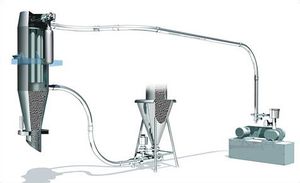Vacuum Conveyors
With vacuum conveying, materials are drawn to the delivery point through a totally enclosed pipeline, in a clean, contained stream of air generated by a vacuum pump.
In vacuum conveying, no moving parts contact the materials, no dust escapes into the atmosphere and no contamination can enter the system.
Often used for food and pharmaceutical applications, mirror polished stainless steel hoppers and receiving vessels meet the strictest hygiene standards and are easily disassembled for routine cleaning and product change.
Working principle
The vacuum pump generates a vacuum in the Vacuum Conveyors separator tank. Air rushes in through the hose/pipe and the suction inlet from the feeding point. The bulk material is aspirated and then carried in this air stream. Inside the separator tank a filter module separates air and product. The transported material is kept and collected in the separator. With fine dust a cyclone element inserted into the separator provides higher transportation capacities because of a lower load of the filter elements. When the separator is filled with product, the vacuum pump switches off, inside of the vacuum conveyor the pressure is balanced to surrounding area within tenths of a second. The separated material discharges from the vacuum conveyor through the discharge element and falls directly into the unit or tank to be charged. Along with the discharging the filter module is cleaned automatically by an air shock system. The occasional filter cake is released from the filter unit. Volkmann offers piston vibrators and fluidizing units to improve the discharging for sticky or highly bridging bulk materials. After unloading the product the discharge element closes and the whole conveying cycle starts again.
The Advantages Of Vacuum Conveying
- Safety
- Hygiene
- Flexibility
- Automation
- Dust free operation
- No contamination
